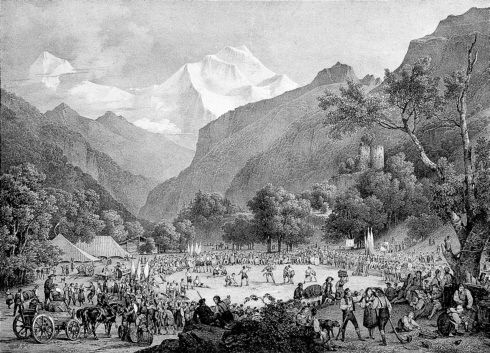Unspunnen Castle on:
[Wikipedia]
[Google]
[Amazon]
 Unspunnen Castle is a
Unspunnen Castle is a Swiss World.org
/ref> overlooks the city of Interlaken. Today, Unspunnen is home to '' Unspunnenfest'', a festival of traditional Swiss competitions held in the fields below the ruins.
{{Authority control Castles in the Canton of Bern Interlaken
 Unspunnen Castle is a
Unspunnen Castle is a castle
A castle is a type of fortification, fortified structure built during the Middle Ages predominantly by the nobility or royalty and by Military order (monastic society), military orders. Scholars usually consider a ''castle'' to be the private ...
, now in ruins, located in the municipality
A municipality is usually a single administrative division having municipal corporation, corporate status and powers of self-government or jurisdiction as granted by national and regional laws to which it is subordinate.
The term ''municipality' ...
of Wilderswil in the Bernese Highlands of Switzerland
Switzerland, officially the Swiss Confederation, is a landlocked country located in west-central Europe. It is bordered by Italy to the south, France to the west, Germany to the north, and Austria and Liechtenstein to the east. Switzerland ...
. The castle, likely constructed in the early 12th century,/ref> overlooks the city of Interlaken. Today, Unspunnen is home to '' Unspunnenfest'', a festival of traditional Swiss competitions held in the fields below the ruins.
History
The castle was the center of a 13th–14th-centuryfief
A fief (; ) was a central element in medieval contracts based on feudal law. It consisted of a form of property holding or other rights granted by an overlord to a vassal, who held it in fealty or "in fee" in return for a form of feudal alle ...
of an Oberland barons, though the name of the barons or the castle builder is unknown. The cave castle of Rotenfluh (first mentioned in 1298 as ''munitio immersive balma Rothenfluo dicta'') at Tschingelsatz and Unspunnen Castle (first mentioned in 1232 as ''Uspunnun'') were used to guard the late medieval
The late Middle Ages or late medieval period was the period of European history lasting from 1300 to 1500 AD. The late Middle Ages followed the High Middle Ages and preceded the onset of the early modern period (and in much of Europe, the Renai ...
''Lütschinenbrücke'', a bridge at Gsteig near Interlaken. In the 13th century it belonged to the ''Herrschaft
The German term ''Herrschaft'' (plural: ''Herrschaften'') covers a broad semantic field and only the context will tell whether it means, "rule", "power", "dominion", "authority", "territory" or "lordship". In its most abstract sense, it refers ...
'' of Burkart of Thun, who acquired it through his 1224 marriage to the family of the Baron of Wädenswil. A division of inheritance, possibly in 1280, cut the ''Herrschaft'' in half, the Baron of Eschenbach got the castle and the surrounding villages while the Baron of Weissenburg got Rotenfluh Castle along with other villages. After the assassination of Albert I of Germany
Albert I of Habsburg () (July 12551 May 1308) was a List of rulers of Austria, Duke of Austria and Duchy of Styria, Styria from 1282 and List of German monarchs, King of Germany from 1298 until his assassination. He was the eldest son of King Ru ...
by his nephew John
John is a common English name and surname:
* John (given name)
* John (surname)
John may also refer to:
New Testament
Works
* Gospel of John, a title often shortened to John
* First Epistle of John, often shortened to 1 John
* Second E ...
in 1308 the Habsburg
The House of Habsburg (; ), also known as the House of Austria, was one of the most powerful dynasties in the history of Europe and Western civilization. They were best known for their inbreeding and for ruling vast realms throughout Europe d ...
in Austria claimed the Eschenbach lands, but in 1318 they pledged these lands to the Baron of Weissenburg as collateral. In 1332, the peasants of the surrounding villages unsuccessfully rose up against Johann of Weissenburg and the leaders were imprisoned in the castle. In 1334, the Oberhasli region was invaded by Bern
Bern (), or Berne (), ; ; ; . is the ''de facto'' Capital city, capital of Switzerland, referred to as the "federal city".; ; ; . According to the Swiss constitution, the Swiss Confederation intentionally has no "capital", but Bern has gov ...
and the castle was besieged. After Bern took the castle, the prisoners were freed, though the barons retained the castle.
After the Bernese victory in the Battle of Laupen in 1339, the barons were forced to pledge the Unspunnen and Rotenfluh castles as part of the peace settlement. A few years later, in 1342, the Habsburgs redeemed this pledge and then pledged it on to their followers, including the lords of Interlaken, Hallwyl and Kyburg. During the Battle of Sempach
The Battle of Sempach was fought on 9 July 1386, between Leopold III, Duke of Austria and the Old Swiss Confederacy. The battle was a decisive Swiss victory in which Duke Leopold and numerous Austrian nobles died. The victory helped turn the lo ...
in 1386, Bern occupied the area and in 1397 paid off the mortgage. In the next year they sold the castle and lands to the von Seftigen and von Scharnachtal families, who were citizens of Bern. In 1418 and again in 1515, Bern bought the lands back from the families' heirs. Bern placed the Unspunnen lands directly under the city's authority in 1529. In 1762 the lands were transferred to the administration of Interlaken and the castle was allowed to fall into disrepair. The ruins became famous through the Unspunnenfest in 1805 which led to regular cleaning and repairs of the ruins.
References
External links
*{{Authority control Castles in the Canton of Bern Interlaken